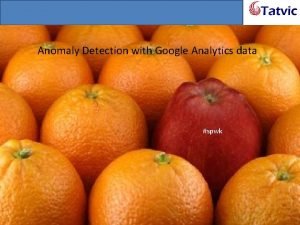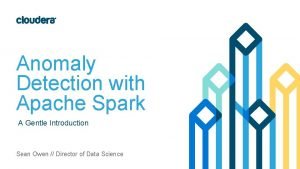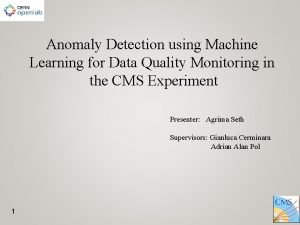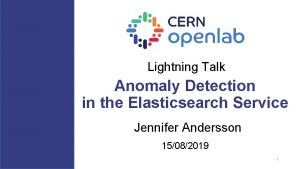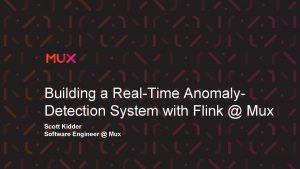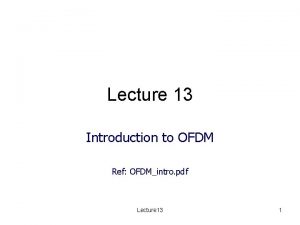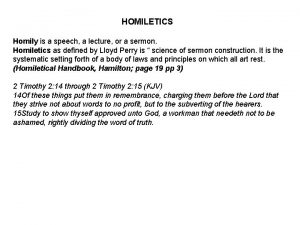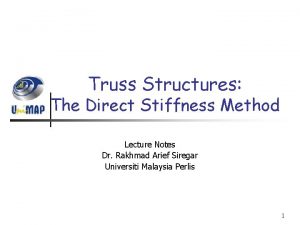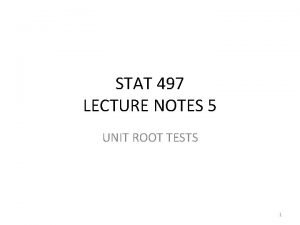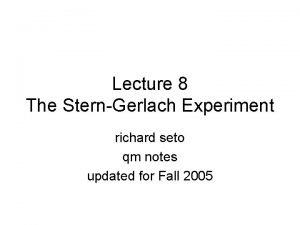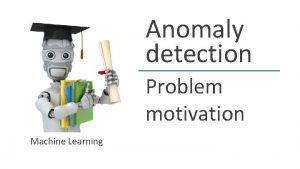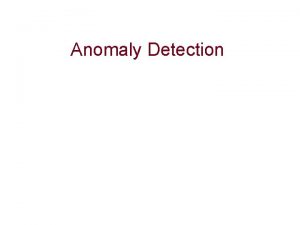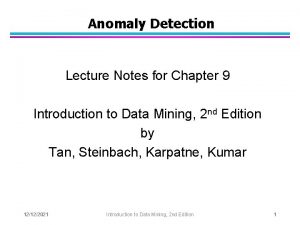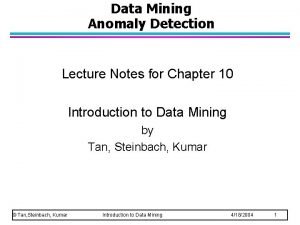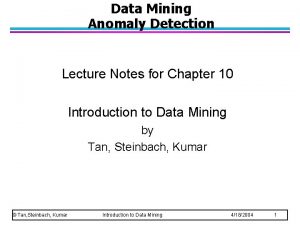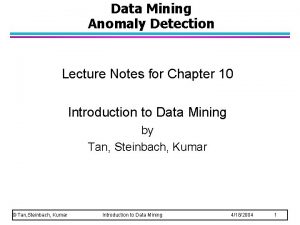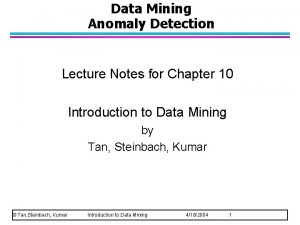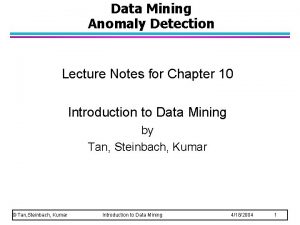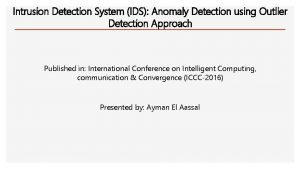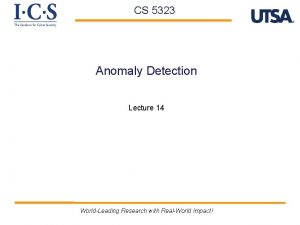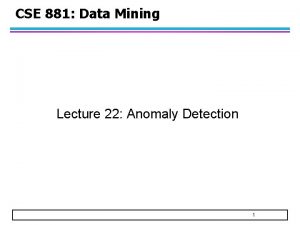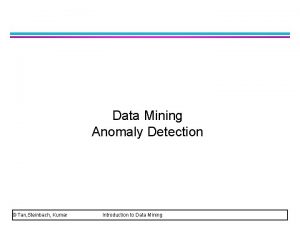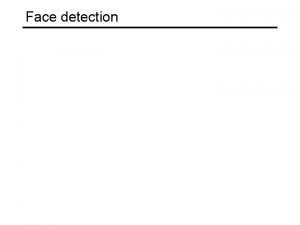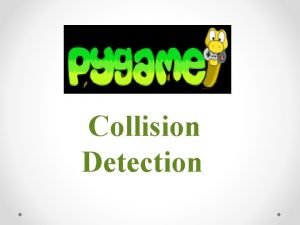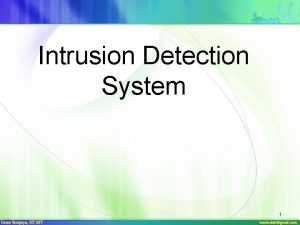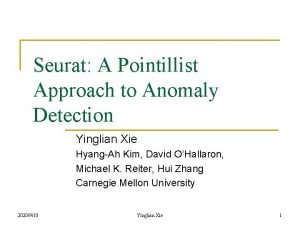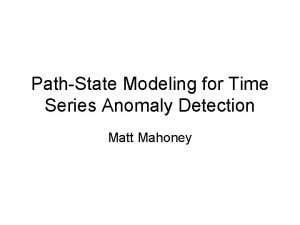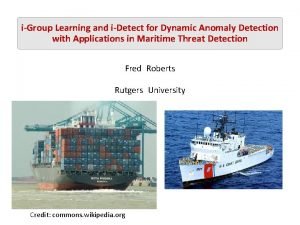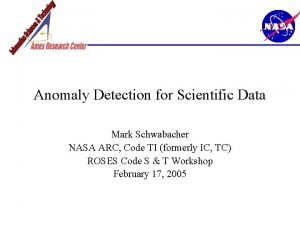Anomaly Detection Lecture Notes for Chapter 9 Introduction















































- Slides: 47

Anomaly Detection Lecture Notes for Chapter 9 Introduction to Data Mining, 2 nd Edition by Tan, Steinbach, Karpatne, Kumar 11/26/2019 Introduction to Data Mining, 2 nd Edition Tan, Steinbach, Karpatne, Kumar 1

Anomaly/Outlier Detection l What are anomalies/outliers? – The set of data points that are considerably different than the remainder of the data l Natural implication is that anomalies are relatively rare – One in a thousand occurs often if you have lots of data – Context is important, e. g. , freezing temps in July l Can be important or a nuisance – 200 pound, 2 year old – Unusually high blood pressure 11/26/2019 Introduction to Data Mining, 2 nd Edition Tan, Steinbach, Karpatne, Kumar 2

Importance of Anomaly Detection Ozone Depletion History l In 1985 three researchers (Farman, Gardinar and Shanklin) were puzzled by data gathered by the British Antarctic Survey showing that ozone levels for Antarctica had dropped 10% below normal levels l Why did the Nimbus 7 satellite, which had instruments aboard for recording ozone levels, not record similarly low ozone concentrations? l The ozone concentrations recorded by the satellite were so low they were being treated as outliers by a computer program and discarded! 11/26/2019 Source: http: //www. epa. gov/ozone/science/hole/size. html Introduction to Data Mining, 2 nd Edition Tan, Steinbach, Karpatne, Kumar 3

Causes of Anomalies l Data from different classes – Measuring the weights of oranges, but a few grapefruit are mixed in l Natural variation – Unusually tall people l Data errors – 200 pound 2 year old 11/26/2019 Introduction to Data Mining, 2 nd Edition Tan, Steinbach, Karpatne, Kumar 4

Distinction Between Noise and Anomalies l Noise doesn’t necessarily produce unusual values or objects l Noise is not interesting l Noise and anomalies are related but distinct concepts 11/26/2019 Introduction to Data Mining, 2 nd Edition Tan, Steinbach, Karpatne, Kumar 5

General Issues: Anomaly Scoring l Many anomaly detection techniques provide only a binary categorization – An object is an anomaly or it isn’t – This is especially true of classification-based approaches l Other approaches assign a score to all points – This score measures the degree to which an object is an anomaly – This allows objects to be ranked l In the end, you often need a binary decision – Should this credit card transaction be flagged? – Still useful to have a score 11/26/2019 Introduction to Data Mining, 2 nd Edition Tan, Steinbach, Karpatne, Kumar 6

Variants of Anomaly Detection Problems l Given a data set D, containing mostly normal (but unlabeled) data points, and a test point x, compute the anomaly score of x with respect to D l Given a data set D, find all data points x D with anomaly scores greater than some threshold t l Given a data set D, find all data points x D having the top-n largest anomaly scores 11/26/2019 Introduction to Data Mining, 2 nd Edition Tan, Steinbach, Karpatne, Kumar 7

Model-Based Anomaly Detection l Unsupervised u. Anomalies are those points that don’t fit well u. Anomalies are those points that distort the model l Supervised u. Anomalies are regarded as a rare class u. Need to have training data 11/26/2019 Introduction to Data Mining, 2 nd Edition Tan, Steinbach, Karpatne, Kumar 8

Anomaly Detection Techniques l Statistical Approaches l Proximity-based – Anomalies are points far away from other points l Clustering-based – Points far away from cluster centers are outliers l Reconstruction Based 11/26/2019 Introduction to Data Mining, 2 nd Edition Tan, Steinbach, Karpatne, Kumar 9

Statistical Approaches Probabilistic definition of an outlier: An outlier is an object that has a low probability with respect to a probability distribution model of the data. l Usually assume a parametric model describing the distribution of the data (e. g. , normal distribution) l Apply a statistical test that depends on – Data distribution – Parameters of distribution (e. g. , mean, variance) – Number of expected outliers (confidence limit) l Issues – Identifying the distribution of a data set u Heavy tailed distribution – Number of attributes – Is the data a mixture of distributions? 11/26/2019 Introduction to Data Mining, 2 nd Edition Tan, Steinbach, Karpatne, Kumar 10

Normal Distributions One-dimensional Gaussian Two-dimensional Gaussian 11/26/2019 Introduction to Data Mining, 2 nd Edition Tan, Steinbach, Karpatne, Kumar 11

Grubbs’ Test Detect outliers in univariate data l Assume data comes from normal distribution l Detects one outlier at a time, remove the outlier, and repeat l – H 0: There is no outlier in data – HA: There is at least one outlier l Grubbs’ test statistic: l Reject H 0 if: 11/26/2019 Introduction to Data Mining, 2 nd Edition Tan, Steinbach, Karpatne, Kumar 12

Statistically-based – Likelihood Approach l Assume the data set D contains samples from a mixture of two probability distributions: – M (majority distribution) – A (anomalous distribution) l General Approach: – Initially, assume all the data points belong to M – Let Lt(D) be the log likelihood of D at time t – For each point xt that belongs to M, move it to A u Let Lt+1 (D) be the new log likelihood. u Compute the difference, = Lt(D) – Lt+1 (D) If > c (some threshold), then xt is declared as an anomaly and moved permanently from M to A u 11/26/2019 Introduction to Data Mining, 2 nd Edition Tan, Steinbach, Karpatne, Kumar 13

Statistically-based – Likelihood Approach Data distribution, D = (1 – ) M + A l M is a probability distribution estimated from data l – Can be based on any modeling method (naïve Bayes, maximum entropy, etc. ) A is initially assumed to be uniform distribution l Likelihood at time t: l 11/26/2019 Introduction to Data Mining, 2 nd Edition Tan, Steinbach, Karpatne, Kumar 14

Strengths/Weaknesses of Statistical Approaches l Firm mathematical foundation l Can be very efficient l Good results if distribution is known l In many cases, data distribution may not be known l For high dimensional data, it may be difficult to estimate the true distribution l Anomalies can distort the parameters of the distribution 11/26/2019 Introduction to Data Mining, 2 nd Edition Tan, Steinbach, Karpatne, Kumar 15

Distance-Based Approaches l The outlier score of an object is the distance to its kth nearest neighbor 11/26/2019 Introduction to Data Mining, 2 nd Edition Tan, Steinbach, Karpatne, Kumar 16

One Nearest Neighbor - One Outlier Score 11/26/2019 Introduction to Data Mining, 2 nd Edition Tan, Steinbach, Karpatne, Kumar 17

One Nearest Neighbor - Two Outliers Outlier Score 11/26/2019 Introduction to Data Mining, 2 nd Edition Tan, Steinbach, Karpatne, Kumar 18

Five Nearest Neighbors - Small Cluster Outlier Score 11/26/2019 Introduction to Data Mining, 2 nd Edition Tan, Steinbach, Karpatne, Kumar 19

Five Nearest Neighbors - Differing Density Outlier Score 11/26/2019 Introduction to Data Mining, 2 nd Edition Tan, Steinbach, Karpatne, Kumar 20

Strengths/Weaknesses of Distance-Based Approaches l Simple l Expensive – O(n 2) l Sensitive to parameters l Sensitive to variations in density l Distance becomes less meaningful in highdimensional space 11/26/2019 Introduction to Data Mining, 2 nd Edition Tan, Steinbach, Karpatne, Kumar 21

Density-Based Approaches l Density-based Outlier: The outlier score of an object is the inverse of the density around the object. – Can be defined in terms of the k nearest neighbors – One definition: Inverse of distance to kth neighbor – Another definition: Inverse of the average distance to k neighbors – DBSCAN definition l If there are regions of different density, this approach can have problems 11/26/2019 Introduction to Data Mining, 2 nd Edition Tan, Steinbach, Karpatne, Kumar 22

Relative Density l 11/26/2019 Introduction to Data Mining, 2 nd Edition Tan, Steinbach, Karpatne, Kumar 23

Relative Density Outlier Scores Outlier Score 11/26/2019 Introduction to Data Mining, 2 nd Edition Tan, Steinbach, Karpatne, Kumar 24

Relative Density-based: LOF approach l For each point, compute the density of its local neighborhood l Compute local outlier factor (LOF) of a sample p as the average of the ratios of the density of sample p and the density of its nearest neighbors l Outliers are points with largest LOF value In the NN approach, p 2 is not considered as outlier, while LOF approach find both p 1 and p 2 as outliers p 2 11/26/2019 p 1 Introduction to Data Mining, 2 nd Edition Tan, Steinbach, Karpatne, Kumar 25

Strengths/Weaknesses of Density-Based Approaches l Simple l Expensive – O(n 2) l Sensitive to parameters l Density becomes less meaningful in highdimensional space 11/26/2019 Introduction to Data Mining, 2 nd Edition Tan, Steinbach, Karpatne, Kumar 26

Clustering-Based Approaches l Clustering-based Outlier: An object is a cluster-based outlier if it does not strongly belong to any cluster – For prototype-based clusters, an object is an outlier if it is not close enough to a cluster center – For density-based clusters, an object is an outlier if its density is too low – For graph-based clusters, an object is an outlier if it is not well connected l Other issues include the impact of outliers on the clusters and the number of clusters 11/26/2019 Introduction to Data Mining, 2 nd Edition Tan, Steinbach, Karpatne, Kumar 27

Distance of Points from Closest Centroids Outlier Score 11/26/2019 Introduction to Data Mining, 2 nd Edition Tan, Steinbach, Karpatne, Kumar 28

Relative Distance of Points from Closest Centroid Outlier Score 11/26/2019 Introduction to Data Mining, 2 nd Edition Tan, Steinbach, Karpatne, Kumar 29

Strengths/Weaknesses of Clustering-Based Approaches l Simple l Many clustering techniques can be used l Can be difficult to decide on a clustering technique l Can be difficult to decide on number of clusters l Outliers can distort the clusters 11/26/2019 Introduction to Data Mining, 2 nd Edition Tan, Steinbach, Karpatne, Kumar 30

Reconstruction-Based Approaches Based on assumptions there are patterns in the distribution of the normal class that can be captured using lower-dimensional representations l Reduce data to lower dimensional data l – Can use Principal Components Analysis (PCA) or other dimensionality reduction techniques – Can also use neural networks l Measure the reconstruction error for each object – The difference between original and reduced dimensionality version 11/26/2019 Introduction to Data Mining, 2 nd Edition Tan, Steinbach, Karpatne, Kumar 31

Reconstruction Error l 11/26/2019 Introduction to Data Mining, 2 nd Edition Tan, Steinbach, Karpatne, Kumar 32

Reconstruction of two-dimensional data 11/26/2019 Introduction to Data Mining, 2 nd Edition Tan, Steinbach, Karpatne, Kumar 33

Basic Architecture of an Autoencoder An autoencoder is a multi-layer neural network l The number of input and output neurons is equal to the number of original attributes. l 11/26/2019 Introduction to Data Mining, 2 nd Edition Tan, Steinbach, Karpatne, Kumar 34

Strengths and Weaknesses l Does not require assumptions about distribution of normal class l Can use many dimensionality reduction approaches l The reconstruction error is computed in the original space – This can be a problem if dimensionality is high 11/26/2019 Introduction to Data Mining, 2 nd Edition Tan, Steinbach, Karpatne, Kumar 35

One Class SVM l Use an SVM approach to classify normal objects l Uses the given data to construct such a model l This data may contain outliers l But the data does not contain class labels l How to build a classifier given one class? 11/26/2019 Introduction to Data Mining, 2 nd Edition Tan, Steinbach, Karpatne, Kumar 36

How Does One-Class SVM Work? Uses the “origin” trick l Use a Gaussian kernel l – Every point mapped to a unit hypersphere – Every point in the same orthant (quadrant) l Aim to maximize the distance of the separating plane from the origin 11/26/2019 Introduction to Data Mining, 2 nd Edition Tan, Steinbach, Karpatne, Kumar 37

Two-dimensional One Class SVM 11/26/2019 Introduction to Data Mining, 2 nd Edition Tan, Steinbach, Karpatne, Kumar 38

Equations for One-Class SVM l 11/26/2019 Introduction to Data Mining, 2 nd Edition Tan, Steinbach, Karpatne, Kumar 39

Finding Outliers with a One-Class SVM l 11/26/2019 Introduction to Data Mining, 2 nd Edition Tan, Steinbach, Karpatne, Kumar 40

Finding Outliers with a One-Class SVM l 11/26/2019 Introduction to Data Mining, 2 nd Edition Tan, Steinbach, Karpatne, Kumar 41

Strengths and Weaknesses l 11/26/2019 Introduction to Data Mining, 2 nd Edition Tan, Steinbach, Karpatne, Kumar 42

Information Theoretic Approaches l Key idea is to measure how much information decreases when you delete an observation l Anomalies should show higher gain l Normal points should have less gain 11/26/2019 Introduction to Data Mining, 2 nd Edition Tan, Steinbach, Karpatne, Kumar 43

Information Theoretic Example l Survey of height and weight for 100 participants l Eliminating last group give a gain of 2. 08 − 1. 89 = 0. 19 11/26/2019 Introduction to Data Mining, 2 nd Edition Tan, Steinbach, Karpatne, Kumar 44

Strengths and Weaknesses l Solid theoretical foundation l Theoretically applicable to all kinds of data l Difficult and computationally expensive to implement in practice 11/26/2019 Introduction to Data Mining, 2 nd Edition Tan, Steinbach, Karpatne, Kumar 45

Evaluation of Anomaly Detection l If class labels are present, then use standard evaluation approaches for rare class such as precision, recall, or false positive rate – FPR is also know as false alarm rate l For unsupervised anomaly detection use measures provided by the anomaly method – Reconstruction error or gain l Can also look at histograms of anomaly scores. 11/26/2019 Introduction to Data Mining, 2 nd Edition Tan, Steinbach, Karpatne, Kumar 46

Distribution of Anomaly Scores l Anomaly scores should show a tail 11/26/2019 Introduction to Data Mining, 2 nd Edition Tan, Steinbach, Karpatne, Kumar 47
 Google
Google Anomaly detection spark
Anomaly detection spark Anomaly detection for data quality
Anomaly detection for data quality Elasticsearch anomaly detection
Elasticsearch anomaly detection Flink anomaly detection
Flink anomaly detection System log analysis for anomaly detection
System log analysis for anomaly detection 01:640:244 lecture notes - lecture 15: plat, idah, farad
01:640:244 lecture notes - lecture 15: plat, idah, farad Introduction to biochemistry lecture notes
Introduction to biochemistry lecture notes Introduction to algorithms lecture notes
Introduction to algorithms lecture notes Project procurement management lecture notes
Project procurement management lecture notes Theology proper lecture notes
Theology proper lecture notes Public sector accounting definition
Public sector accounting definition 4 ps of project management
4 ps of project management Magnetism
Magnetism Classical mechanics
Classical mechanics Physical science lecture notes
Physical science lecture notes Power system dynamics and stability lecture notes
Power system dynamics and stability lecture notes Microbial physiology and metabolism lecture notes
Microbial physiology and metabolism lecture notes Ppt on mechatronics
Ppt on mechatronics Limits fits and tolerances lecture notes
Limits fits and tolerances lecture notes Financial engineering lecture notes
Financial engineering lecture notes Bipolar junction transistor lecture notes
Bipolar junction transistor lecture notes Software engineering lecture notes
Software engineering lecture notes Introduction to ofdm
Introduction to ofdm Land use planning '' lecture notes
Land use planning '' lecture notes Project management lecture notes doc
Project management lecture notes doc Lecture notes on homiletics
Lecture notes on homiletics Foundation engineering lecture notes
Foundation engineering lecture notes Image processing lecture notes
Image processing lecture notes Intermediate microeconomics lecture notes
Intermediate microeconomics lecture notes Parallel and distributed computing lecture notes
Parallel and distributed computing lecture notes Bayesian decision theory lecture notes
Bayesian decision theory lecture notes Nonlinear regression lecture notes
Nonlinear regression lecture notes Advanced inorganic chemistry lecture notes
Advanced inorganic chemistry lecture notes Fits and tolerances chart
Fits and tolerances chart Direct stiffness method truss
Direct stiffness method truss Flood routing example
Flood routing example Unit root time series
Unit root time series Shape memory alloys lecture notes
Shape memory alloys lecture notes Research methods notes
Research methods notes Financial institutions and markets lecture notes ppt
Financial institutions and markets lecture notes ppt What is a harmonic wave in physics
What is a harmonic wave in physics Operations management lecture notes doc
Operations management lecture notes doc Natural language processing lecture notes
Natural language processing lecture notes Linux lecture notes
Linux lecture notes Dyphilidium caninum
Dyphilidium caninum Stern-gerlach experiment lecture notes
Stern-gerlach experiment lecture notes Land use planning '' lecture notes
Land use planning '' lecture notes
